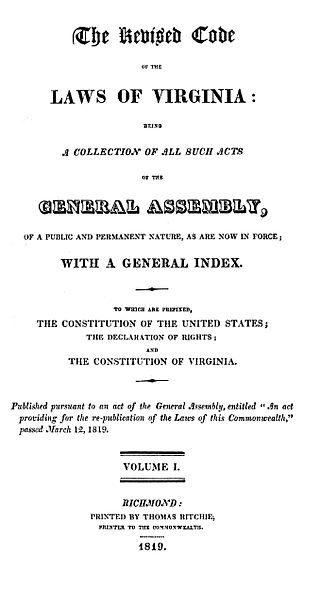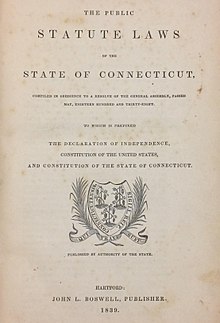
The University of Connecticut (UConn) is a public land-grant research university system whose main campus is in Storrs, Connecticut. It was founded in 1881 as the Storrs Agricultural School, named after two brothers who donated the land for the school. In 1893, the school became a public land grant college, becoming the University of Connecticut in 1939. Over the following decade, social work, nursing and graduate programs were established, while the schools of law and pharmacy were also absorbed into the university. During the 1960s, UConn Health was established for new medical and dental schools. UConn is accredited by the New England Commission of Higher Education.

The Blue Laws of the Colony of Connecticut are an invented set of harsh statutes governing conduct in the Puritan colony, listed in a history of Connecticut that was published in 1781 in London by the Reverend Samuel Peters, an Anglican who had been forced to leave America. Peters' book popularized the term "blue laws", referring to laws restricting activities on Sunday.

The Code of Virginia is the statutory law of the U.S. state of Virginia, and consists of the codified legislation of the Virginia General Assembly. The 1950 Code of Virginia is the revision currently in force. The previous official versions were the Codes of 1819, 1849, 1887, and 1919, though other compilations had been printed privately as early as 1733, and other editions have been issued that were not designated full revisions of the code.
The Daily Campus, founded in 1896, is a student-run newspaper at the University of Connecticut. The Daily Campus has a circulation of 1,500 on weekdays during school term. Since its creation, the newspaper has undergone several name changes, having started as The Storrs Agricultural College Lookout, a monthly, when it published its first issue on May 11, 1896. The name was changed to The Connecticut Campus in 1915, followed by The Connecticut Daily Campus, and then finally The Daily Campus in 1984. It began publishing five days a week during the academic year in 1952 and became a morning paper in 1955.
The Revised Statutes of the United States was the first official codification of the Acts of Congress. It was enacted into law in 1874. The purpose of the Revised Statutes was to make it easier to research federal law without needing to consult the individual Acts of Congress published in the United States Statutes at Large.

Loren Pinckney Waldo was an American politician from Connecticut who served as a Democratic member of the United States House of Representatives from Connecticut.
David M. Borden was a Connecticut Supreme Court Justice from 1990 to 2007.
Minnesota Statutes are a compilation of the official laws of the U.S. state of Minnesota. Minnesota Statutes comprise only of the general and permanent laws of the state. The Office of the Revisor of Statutes publishes a complete set of statutes in odd-numbered years.

The establishment of lesbian, gay, bisexual, and transgender (LGBT) rights in the U.S. state of Connecticut is a recent phenomenon, with most advances in LGBT rights taking place in the late 20th century and early 21st century. Connecticut was the second U.S. state to enact two major pieces of pro-LGBT legislation; the repeal of the sodomy law in 1971 and the legalization of same-sex marriage in 2008. State law bans unfair discrimination on the basis of sexual orientation and gender identity in employment, housing and public accommodations, and both conversion therapy and the gay panic defense are outlawed in the state.

The Piracy Act 1850, sometimes called the Pirates Repeal Act 1850, is an Act of the Parliament of the United Kingdom. It relates to proceedings for the condemnation of ships and other things taken from pirates and creates an offence of perjury in such proceedings.

The Statute Law Revision Act 1893 is an Act of the Parliament of the United Kingdom. Cotton said this Act is the twenty-second Statute Law Revision Act.

The Statute Law Revision Act 1892 is an Act of the Parliament of the United Kingdom. The Bill for this Act was the Statute Law Revision Bill 1892.

Royal Ralph Hinman was an American lawyer and antiquarian who held various public offices in Connecticut, and who wrote on antiquarian subjects.

The law of Michigan consists of several levels, including constitutional, statutory, regulatory and case law. The Michigan Compiled Laws form the general statutory law.

The law of Connecticut is the system of law and legal precedent of the U.S. state of Connecticut. Sources of law include the Constitution of Connecticut and the Connecticut General Statutes.
The Hartford County Sheriff's Department was a 300-person law enforcement agency that served the twenty-nine towns of Hartford County, Connecticut in North Central Connecticut. Hartford County was constituted in 1666. The Code of 1650 of the General Court of Connecticut allowed "the marshall" to collect fees for the service of executions and attachments and fines for breaches of law. In 1698, marshals became "sheriffs." In 1722, sheriffs were given the duty of conserving the peace and could command people to help them. Two years later, each sheriff became responsible for the jail in his county, with the right to appoint people as "keepers." In 1766, limits were placed on the number of deputies a high sheriff could appoint, although on special occasions other people could be used as well.
The following is the planned order of succession for the governorships of the 50 U.S. states, Washington, D.C., and the five organized territories of the United States, according to the constitutions of each. Some states make a distinction whether the succeeding individual is acting as governor or becomes governor.
The Code of the District of Columbia is the codification of the general and permanent laws relating to the District of Columbia. It was enacted and is revised by authority of the Congress of the United States.

Willis Nichols Hawley was an American soldier who died of typhoid fever during the Spanish–American War. Hawley was the first student or alumnus of the University of Connecticut to die while on active duty during wartime. The Willis Nichols Hawley Armory on the university's campus in Storrs was named in his honor.

Citation of Canadian legislation is the system of citing Canadian statutes and regulations in court decisions, briefs of law, and articles in law journals. The purpose of a citation is to allow the reader to understand the source of the legislative principle being cited, and to find the law in question. It is a type of legal citation, namely a "reference to a legal precedent or authority, such as a case, statute, or treatise, that either substantiates or contradicts a given position".













